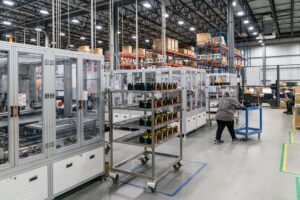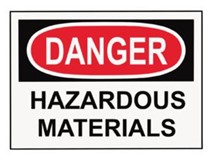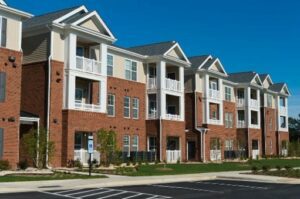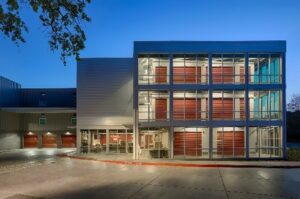Occupancy Classifications in the International Building Code

Understanding the various occupancy classifications as defined by the International Building Code (IBC) is crucial for architects, builders, and fire safety professionals. These classifications play a significant role in determining the design requirements and safety measures, including fire sprinkler systems, needed for the diverse types of buildings identified in the IBC. This blog aims to provide a detailed overview of occupancy classifications based on the IBC, underscoring the importance of, and adherence to, these standards in ensuring the safety and well-being of occupants. It is important to point out that the occupancy classifications listed in the IBC are different than the hazard classifications listed in NFPA 13.
Occupancy Classifications in the International Building Code:
-
Assembly Occupancy (Section 303)
-
Business Occupancy (Section 304)
-
Educational Occupancy (Section 305)
-
Factory and Industrial (Section 306)
-
High Hazard (Section 307)
-
Institutional Occupancy (Section 308)
-
Mercantile Occupancy (Section 309)
-
Residential Occupancy (Section 310)
-
Storage Occupancy (Section 311)
-
Utility and Miscellaneous (Section 312)
Assembly Occupancy (Section 303):

Assembly occupancies are divided into five subgroups (Groups A-1 through A-5) and are classified by how the building or structure is used. Assembly occupancies include buildings used for gatherings of people for purposes such as civic, social, or religious functions, recreation, food, or drink consumption, or awaiting transportation. Examples include theaters, dance halls, banquet halls, auditoriums, arenas, and stadiums.
The specific group (A-1 through A-5) depends on the nature of the activities conducted. It’s also important to point out that smaller assembly spaces, defined as having an occupant load of less than 50, are considered Group B occupancies, accessory to the primary occupancy, or grouped with the overall occupancy classification. This exempts small coffee shops, conference rooms, etc. with an occupant load of less than 50 from the more stringent Group A requirements.
Business Occupancy (Section 304):
 Group B or Business occupancies include buildings or portions thereof used for office, professional, or service-type transactions. Group B occupancies may have accessory use spaces used for the storage of records and accounts. Buildings under this category are designed for services such as banks, professional services, and academic areas above the 12th grade (tech schools, colleges, universities, etc.). The key concern in such occupancies is the safety of personnel and customers, but it can also include the protection of valuable documents and materials.
Group B or Business occupancies include buildings or portions thereof used for office, professional, or service-type transactions. Group B occupancies may have accessory use spaces used for the storage of records and accounts. Buildings under this category are designed for services such as banks, professional services, and academic areas above the 12th grade (tech schools, colleges, universities, etc.). The key concern in such occupancies is the safety of personnel and customers, but it can also include the protection of valuable documents and materials.
Educational Occupancy (Section 305):
 Group E, or Educational occupancies, refers to buildings used for educational purposes through the 12th grade by six or more people for four or more hours per day or more than 12 hours per week. This includes schools, preschools, and some daycare facilities.
Group E, or Educational occupancies, refers to buildings used for educational purposes through the 12th grade by six or more people for four or more hours per day or more than 12 hours per week. This includes schools, preschools, and some daycare facilities.
The design and fire protection in such facilities are highly regulated to ensure the safety of children and staff. It is important to review the IBC carefully since day care occupancies can be considered a Group E or Group I-4 depending on the ages of the children in the program. The differences in fire protection requirements between these two occupancies is significant.
Factory and Industrial (Section 306):
 Groups F-1 and F-2 cover Factory and Industrial occupancies where goods are manufactured or processed. Group F-1 (moderate-hazard) includes factories where materials that are not highly flammable or combustible are made or processed, while Group F-2 (low-hazard) includes buildings where goods are produced in a primarily non-combustible environment. Safety measures are important in these occupancies due to the potential hazards associated with machinery and stored materials as well as the safety for responding firefighters who may need to enter the property.
Groups F-1 and F-2 cover Factory and Industrial occupancies where goods are manufactured or processed. Group F-1 (moderate-hazard) includes factories where materials that are not highly flammable or combustible are made or processed, while Group F-2 (low-hazard) includes buildings where goods are produced in a primarily non-combustible environment. Safety measures are important in these occupancies due to the potential hazards associated with machinery and stored materials as well as the safety for responding firefighters who may need to enter the property.
High Hazard (Section 307):
 Groups H-1 through H-5 categorize High Hazard occupancies which involve the manufacturing, processing, generation, or storage of materials that constitute a high fire, explosion, or health hazard. Each subgroup, from H-1 (most hazardous) to H-5, indicates a decreasing level of hazard. Strict compliance with fire safety and sprinkler systems in Group H occupancies is non-negotiable to mitigate potential risks for the building occupants and responding firefighters. The requirements for Group H occupancies are some of the most restrictive in the model codes.
Groups H-1 through H-5 categorize High Hazard occupancies which involve the manufacturing, processing, generation, or storage of materials that constitute a high fire, explosion, or health hazard. Each subgroup, from H-1 (most hazardous) to H-5, indicates a decreasing level of hazard. Strict compliance with fire safety and sprinkler systems in Group H occupancies is non-negotiable to mitigate potential risks for the building occupants and responding firefighters. The requirements for Group H occupancies are some of the most restrictive in the model codes.
Institutional Occupancy (Section 308):
 Institutional occupancies, Groups I-1 through I-4, include facilities like hospitals, nursing homes, prisons, daycares with more than five children under the age of 2 ½, and some assisted living properties where people are cared for on a 24-hour basis. These facilities require special care in fire safety planning due to the nature of the occupants and their ability or inability to evacuate with/without staff assistance.
Institutional occupancies, Groups I-1 through I-4, include facilities like hospitals, nursing homes, prisons, daycares with more than five children under the age of 2 ½, and some assisted living properties where people are cared for on a 24-hour basis. These facilities require special care in fire safety planning due to the nature of the occupants and their ability or inability to evacuate with/without staff assistance.
Mercantile Occupancy (Section 309):
 Group M or Mercantile occupancies includes buildings used for the display and sale of merchandise, such as department stores and markets. These environments often have a high load of combustibles, are frequented by the public who may be unfamiliar with the building, and some mercantile occupancies can have high occupant load numbers, which necessitates the need to comply with certain fire and life safety requirements outlined in the IBC.
Group M or Mercantile occupancies includes buildings used for the display and sale of merchandise, such as department stores and markets. These environments often have a high load of combustibles, are frequented by the public who may be unfamiliar with the building, and some mercantile occupancies can have high occupant load numbers, which necessitates the need to comply with certain fire and life safety requirements outlined in the IBC.
Residential Occupancy (Section 310):
 Groups R-1 through R-4 define Residential occupancies ranging from hotels (R-1) to apartment buildings (R-2), as well as one- and two-family homes (R-3) and residential care facilities (R-4). The design and fire safety requirements vary depending on the classification. Group R occupancies have very restrictive fire protection requirements since most fire deaths occur in occupancies where people sleep.
Groups R-1 through R-4 define Residential occupancies ranging from hotels (R-1) to apartment buildings (R-2), as well as one- and two-family homes (R-3) and residential care facilities (R-4). The design and fire safety requirements vary depending on the classification. Group R occupancies have very restrictive fire protection requirements since most fire deaths occur in occupancies where people sleep.
Storage Occupancy (Section 311):
 Groups S-1 and S-2 are Storage occupancies, which include buildings used for storage that are not classified as a high-hazard. S-1 buildings are used for materials that are combustible, while S-2 buildings are for non-combustible materials. Fire protection needs vary based on the combustibility and quantity of stored items. It is important to point out that Group S occupancies may also need to comply with Chapter 32 in the International Fire Code (IFC). Chapter 32 in the IFC contains more restrictive fire protection requirements for high-piled storage. The high-piled storage requirements apply if the height of the storage exceeds twelve feet for Class I-IV commodities or six feet for high-hazard commodities.
Groups S-1 and S-2 are Storage occupancies, which include buildings used for storage that are not classified as a high-hazard. S-1 buildings are used for materials that are combustible, while S-2 buildings are for non-combustible materials. Fire protection needs vary based on the combustibility and quantity of stored items. It is important to point out that Group S occupancies may also need to comply with Chapter 32 in the International Fire Code (IFC). Chapter 32 in the IFC contains more restrictive fire protection requirements for high-piled storage. The high-piled storage requirements apply if the height of the storage exceeds twelve feet for Class I-IV commodities or six feet for high-hazard commodities.
Utility and Miscellaneous (Section 312):
 Group U covers Utility and Miscellaneous occupancies, which include buildings of an accessory character and miscellaneous structures not classified in any specific occupancy. This includes agricultural buildings, carports, and fences over six feet high. While these structures might not be primary buildings and fire protection requirements in the model codes are often minimal, these buildings can still present unique challenges for firefighting personnel based on how the structure is used.
Group U covers Utility and Miscellaneous occupancies, which include buildings of an accessory character and miscellaneous structures not classified in any specific occupancy. This includes agricultural buildings, carports, and fences over six feet high. While these structures might not be primary buildings and fire protection requirements in the model codes are often minimal, these buildings can still present unique challenges for firefighting personnel based on how the structure is used.
In conclusion, understanding the ten different occupancy classifications in the IBC is essential for ensuring the safety of building occupants. Each classification comes with its own set of requirements and considerations, especially concerning fire protection and automatic sprinkler systems. As members of the National Fire Sprinkler Association and allied professionals, staying informed and compliant with these standards is not just a regulatory requirement; it is a commitment to safeguarding lives and properties.
HAVE A QUESTION ABOUT OCCUPANCY CLASSIFICATIONS? CONTACT THE NFSA TODAY
Members and employees of NFSA work very closely in the codes and standards development process. Our team of experts stays on the cutting edge of fire protection issues by participating in over 250 codes and standards development committees. If you have an interest in NFSA’s mission to protect lives and property through the widespread acceptance of the fire sprinkler concept, or you simply want to get more involved in the codes and standards process with NFSA, please visit our membership page.
More about the author
John Swanson currently serves as NFSA’s Codes and Standards Specialist. In this role he provides training and education and represents NFSA on code and standards technical committees. He currently serves as a Principal member of the NFPA 72 – National Fire Alarm and Signaling Code Technical Committee and is a member of the International Building Code (IBC) Fire Safety Committee and past member of the International Fire Code (IFC) Interpretation Committee.
From 2013-2017, John served as a fire service representative appointed by Minnesota Governor, Mark Dayton to the Minnesota Board of Architecture and Engineering.
